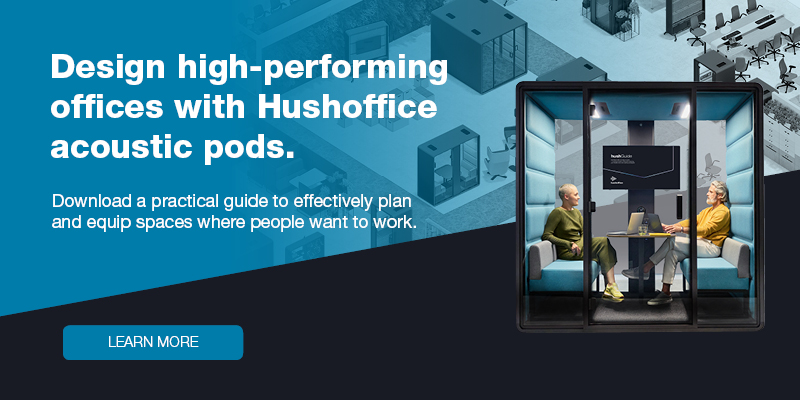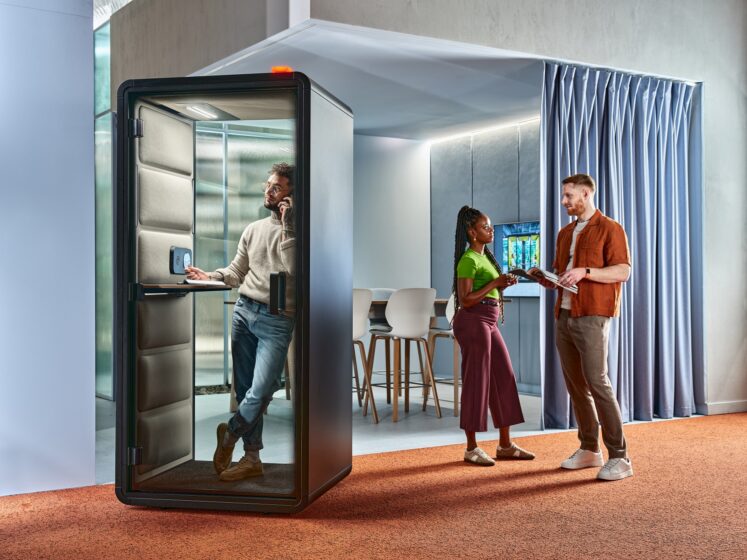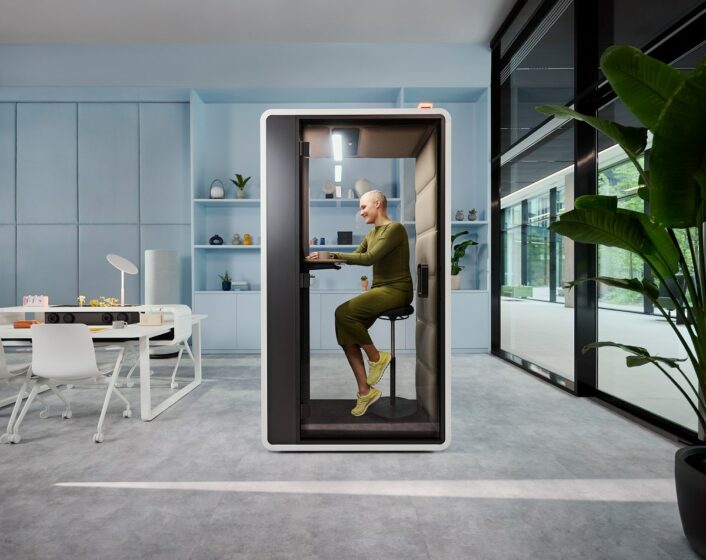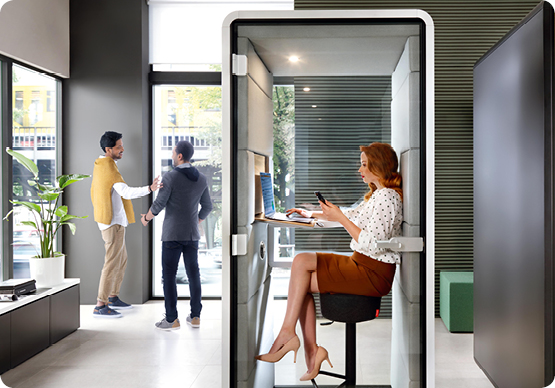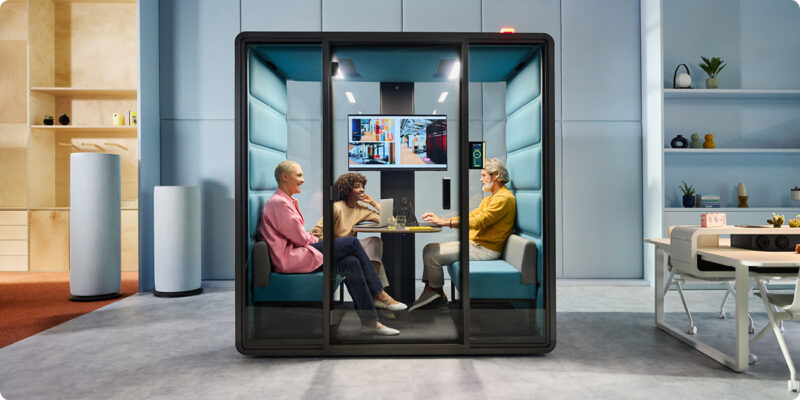How will the metaverse influence office design?
- Posted on: 19 December 2023
- By: Hushoffice Team
The metaverse is expected to produce up to $5 trillion in revenue by 2030. Naturally, businesses that don’t participate in it, face a competitive handicap. So, the question arises: how to surf the metaverse wave and keep up-to-date? We believe that the office should foster its integration without losing sight of social connection. Let’s have a look.
How will the metaverse change office design – tl;dr
The metaverse can be described as a supercharged Internet or a digital world coexisting with our physical realm. It’s a kind of virtual reality turned into an intuitive and immersive space with the use of VR, AR, and similar advanced technologies combining the digital and physical realms into one reality. According to leading visionaries, the metaverse will gradually change the world of work, offering more engaging and immediate connections via video conferencing, and more genuine online collaboration using, for example, 3D holographic technology.
Up to 58% of businesses have integrated some aspects of the metaverse into their organisation. However, only 1 out of 5 tech employees claim that metaverse technologies are actually accessible in their work. And around 50% of workers under 40 anticipate carrying out their duties in the metaverse in the near future.
Despite its enormous potential, full-time virtual working in the metaverse has its considerable challenges, too. The lack of clear work-life balance boundaries, a sense of isolation, and time management issues take the lead. What’s more, the shortage of private workspaces in the home setting can make the idea of full-time remote working in the metaverse undesirable for a large number of employees. Therefore, the office needs to provide top-notch work and meeting spaces, such as Hushoffice pods, facilitating social aspects of work and adding the human element that makes work a satisfying and productive experience.
Only 1 out of 5 tech employees say that metaverse technologies are actually accessible in their work.
On the other hand, Microsoft’s 2022 Work Trends Index shows that a half of workers under 40 anticipate carrying out their duties in the metaverse in the near future. Actually, so far 58% of businesses have integrated some aspects of the metaverse into their organisation. In a nutshell, the metaverse is inevitable.
What is the definition of the metaverse?
Imagine a world where the physical realm blends with the virtual one, and the boundaries between them become indistinguishable. The concept of metaverse has stimulated the imagination of tech enthusiasts, visionaries, and futurists. Essentially, the idea is a collective virtual space being a realm where the tangible and digital realities blend into a surrounding, interrelated universe
– says Mateusz Barczyk, Senior Brand Manager, Hushoffice.The metaverse can be defined as an immersive version of the Internet – a digital environment co-existing with the physical world. It’s a shared, interactive and extremely realistic virtual space. With the use of VR, AR, and similar advanced technologies, this 3D-enabled space offers lifelike individual and professional experiences online.
The metaverse can be something different to different people.
For some, it is a virtual playground for friends. Others recognise its potential to become a commercial space for businesses and customers. And for some, the metaverse is a remote workspace enhancing the way we collaborate, making hybrid working hit the high notes.
McKinsey’s in-depth research reveals three features of the metaverse.
These features include: a sense of immersion, real-time interactivity, and user agency. They say that powering the metaverse will rely on seamless work of platforms and devices, simultaneous interaction among thousands of users, and a wide range of use cases, including its use in professional settings.
The metaverse is streamlined by a combination of modern technologies.
These technologies include virtual reality, augmented reality, mixed reality, 5G, blockchain, digital currencies, and AI. All the tools supporting smooth navigation across the physical and digital realms are powering the creation of the metaverse.
The aim of the metaverse isn’t to escape reality.
In fact, it aims at “embracing and augmenting reality.” According to experts, the content experiences of the metaverse will make work and life more satisfying, ensuring a stronger connection to our nearest and dearest and improving our work performance. Actually, some claim that the metaverse is all about community.
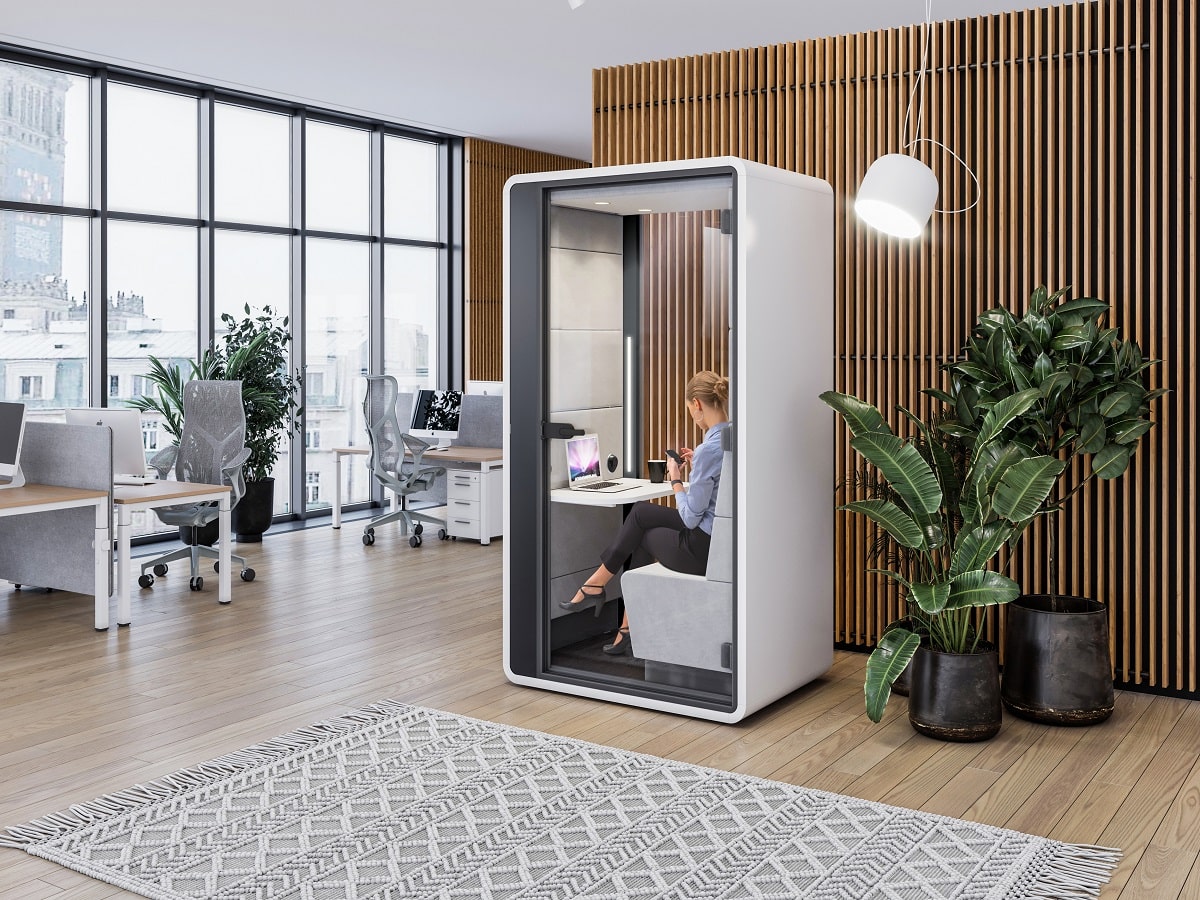
According to a 2022 PwC survey, two thirds of companies were actively participating in the metaverse.
Additionally, 82% are planning to include the metaverse into their business activities within the next three years.
So, how can you implement the metaverse in the office and at work?
“…employers are using the metaverse to improve onboarding and training… collaborating and interacting in new ways. While business leaders aren’t sure of what lies ahead, they recognize that the metaverse has the potential to change — and improve — the way business and work is done,” says SHRM.
According to Gartner’s predictions, 25% of people are expected to spend a minimum of one hour a day in the metaverse by 2026. In their team’s view, the metaverse will allow businesses to enhance involvement, collaboration, and connection to workers due to the immersive workspaces of virtual offices. Anything more?
Undeniably, the metaverse holds substantial potential for revolutionising the workspace.
As per PwC’s 2022 US Metaverse Survey, potential uses for the metaverse in the work-related settings vary from customer support to talent recruitment. As for now, much of the required technology is in the initial phase of development, so it remains to be seen how the metaverse will actually influence our habits and behaviours.
According to PwC’s survey, 42% of respondents would like to use the metaverse for onboarding and training. 36% – to communicate with their colleagues. 35% – to interact with customer-facing staff. 29% – to provide a try-before-you-buy experience, and 28% to offer premium products and services. Interestingly, 25% of the respondents would like to use the metaverse to sell digital versions of existing products. So, there are many potential use cases
– says Mateusz Barczyk, Senior Brand Manager, Hushoffice.An essential note: “real life” is the fundamental aspect of a metaverse reality.
There are a number of significant challenges that a metaverse work world needs to face. The lack of clear work-life balance boundaries, a sense of isolation, and time management issues take the lead. The shortage of private workspaces in the home setting can make the idea of full-time remote working in a metaverse future undesirable for many employees.
It’s crystal clear that the office will be an essential complement to remote, digital style of work once the metaverse world evolves. It functions as a physical line between work and life. Its daily hustle and bustle takes the edge off tedious screen-based work. When adequately equipped with private workspaces, such as pods, the office becomes a functionally apt space for concentrative work. When such measures are implemented, the workplace will remain a significan complement to virtual working. And more importantly, it will become a more precious complement, the more virtual our working world gets
– adds Mateusz Barczyk, Senior Brand Manager, Hushoffice.
A remote work structure that doesn’t bring employees together weakens company culture.
Work friendships boost productivity and a sense of belonging enhances commitment and engagement. Although modern solutions, such as VR video calls can encourage both by making online meetings feel more real, nothing compares to the real thing.
The natural, linear flow of life, happening in real-time is a calming, indispensable experience that everyone needs.
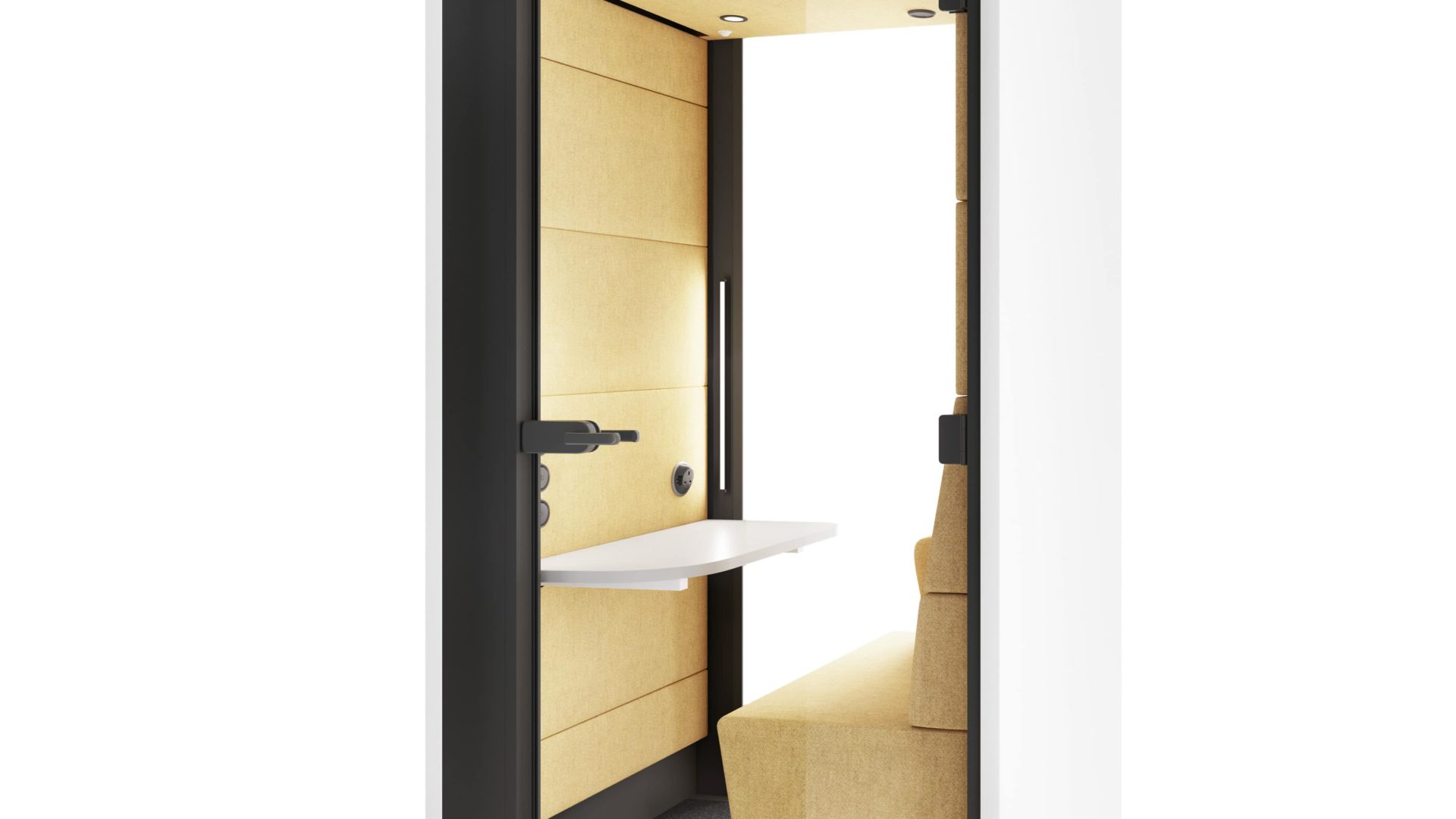
Find out more: Digital mindfulness is a matter of well-being
Hushoffice pods – a vital linking element in a metaverse workplace.
There is no escaping from the natural human need for face-to-face interaction. However, in a hybrid working world, the office is an unforeseeable space of come-and-go employees. In order to connect or make calls, teammates need an environment where privacy, peacefulness, and stability are guaranteed. That’s why our pods are a perfect solution. Every pod from our Hushoffice collection is fully-featured, comfortably furnished, and acoustically superior, offering excellent speech privacy and granting a reassuring sense of autonomy over one’s space
– says Mateusz Barczyk, Senior Brand Manager, Hushoffice.
Consider the basic options: the hushPhone office call booth, the hushMeet 4-person meeting booth, and the hushMeet.L large conference cabin for 8. Equipped with a booking system synchronisable by email, Hushoffice pods satisfy the need for real connection in the metaverse world.
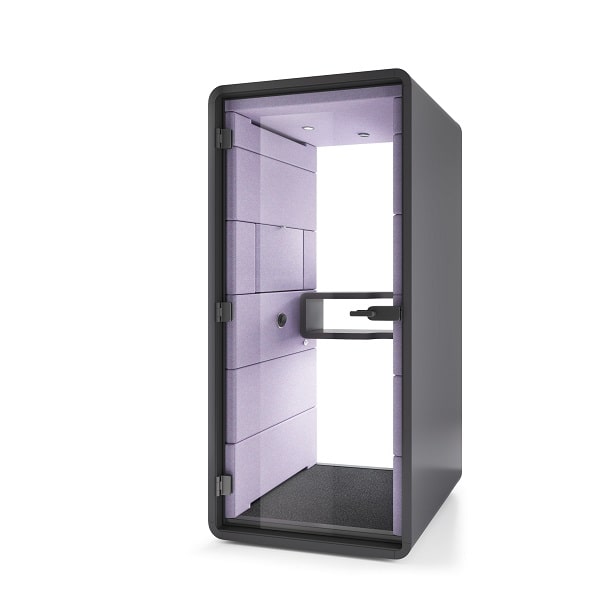
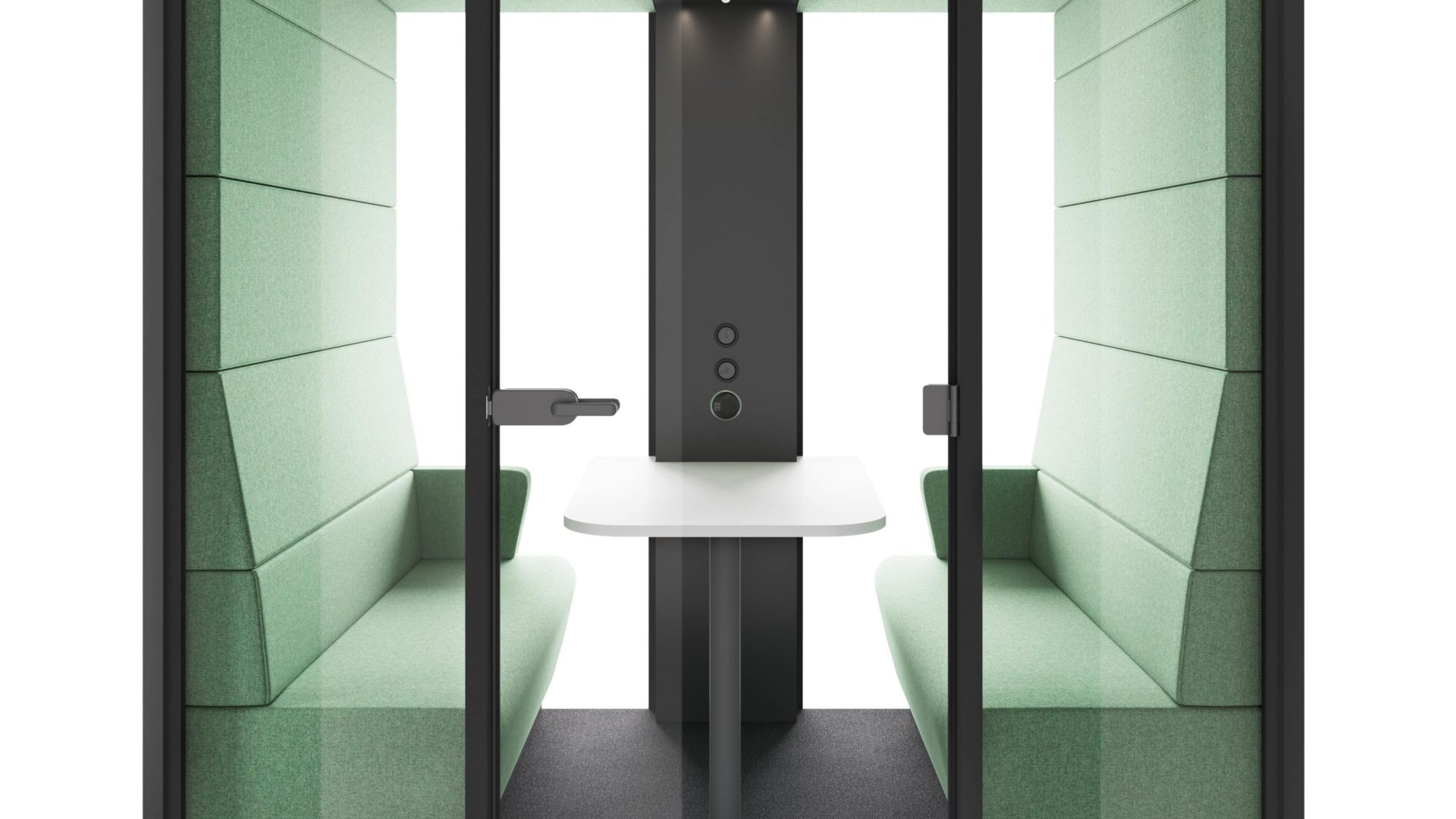

How will the metaverse change office design – summary
The metaverse can be described as a supercharged Internet or a digital world coexisting with our physical realm. It’s a kind of virtual reality turned into an intuitive and immersive space with the use of VR, AR, and similar advanced technologies combining the digital and physical realms into one reality. According to leading visionaries, the metaverse will gradually change the world of work, offering more engaging and immediate connections via video conferencing and more genuine online collaboration using, for example, 3D holographic technology.
Up to 58% of businesses have integrated some aspects of the metaverse into their organisation. However, only 1 out of 5 tech employees claim that metaverse technologies are actually accessible in their work. And around 50% of workers under 40 anticipate carrying out their duties in the metaverse in the near future.
Despite its enormous potential, full-time virtual working in the metaverse has its considerable challenges, too. The lack of clear work-life balance boundaries, a sense of isolation, and time management issues take the lead. What’s more, the shortage of private workspaces in the home setting can make the idea of full-time remote working in the metaverse undesirable for a large number of employees. Therefore, the office needs to provide top-notch work and meeting spaces, such as Hushoffice pods, facilitating social aspects of work and adding the human element that makes work a satisfying and productive experience.
The impact of metaverse on office design – frequently asked questions
How can we use the metaverse in the workspace?
For immersive online meetings, allowing employees to work in a collaborative, user-friendly digital environment. To add a new quality to training sessions by using realistic simulations. To provide more involving virtual spaces for brainstorming and troubleshooting sessions. And most impressively, the metaverse can become a platform for marketing, product presentations, and customer involvement, allowing businesses to reach new audiences in creative ways.
How can the metaverse influence the future of work?
For sure, the metaverse may revolutionise teamwork, training, and video conferencing. However, introducing it into everyday work has many challenges, ranging from technological to cultural ones. Although the metaverse is expected to produce up to $5 trillion in revenue by 2030, it remains to be seen whether it becomes the dominant framework for all work forms. So far 58% of businesses have integrated some aspects of the metaverse into their organisation, and around 50% of workers under 40 anticipate carrying out their duties in the metaverse in the near future.
What makes the metaverse an important issue for businesses?
The metaverse provides an international platform for efficient collaboration, affordable training, and creativity in problem-solving. It allows companies to engage with customers in more innovative ways. And, to possibly gain a competitive edge. It can also minimise real estate costs and enhance employee work-life balance. Companies that address its challenges, such as privacy, isolation, or security, may leverage the potential of the metaverse. As a result, they may optimise operations, become more innovative, and engage with stakeholders in innovative ways.

